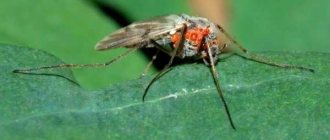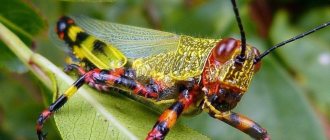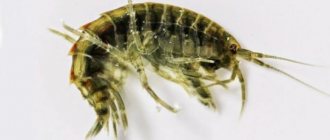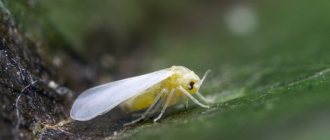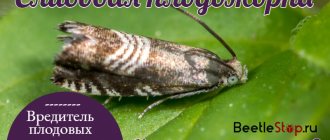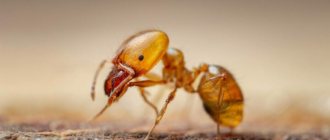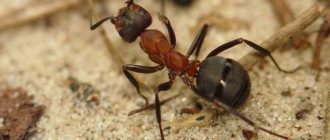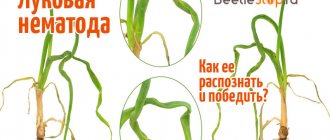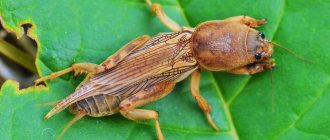The flour mite is a tiny creature that, despite its small size, forces you to throw away all infected supplies. This arachnid, being a very common type of barn pest, can cause significant economic damage. Today we will consider in detail its harmfulness, as well as the main methods of control and prevention.
What is a flour mite?
There are pests of plants, grains, and other food products, which are quite problematic to get rid of. Among them we can distinguish the flour mite or, as it is also called, the granary mite. It would seem, what harm can an insect whose size is less than a centimeter cause? In fact, with the appearance of this arachnid, food begins to deteriorate and rot.
It is quite difficult to notice the flour mite due to its small size and color. The body is white, the legs are brown. He has quite strong and powerful paws, thanks to which he calmly moves on a flat vertical surface (for example, glass).
Females live relatively short lives. In summer 2-3 months, in winter up to 6 months. During this period they are able to lay up to 200 eggs. The flour mite feeds on wheat grains, flax seeds, legumes and others. The most delicious food for him is the one that is rich in fatty compounds.
Habitat and diet
The flour mite is perfectly adapted to life in various conditions. It can easily tolerate extremely low or high temperatures. The same applies to laid eggs, which do not die at temperatures ranging from -5 to +60 degrees Celsius.
The grain mite can settle in the following places:
- warehouses where grain crops are stored;
- accumulations of straw;
- haystacks;
- livestock habitats;
- bakeries and other places where flour is stored;
- burrows of rodents and other small animals;
- plant remains (accumulation of autumn leaves, waste from wheat and other crops);
- cereal and corn fields;
- grocery stores;
- kitchens in private or multi-storey buildings.
The diet of mealy mites depends on the habitat. Larvae and adults can eat much more than their body weight and therefore cause serious damage to agriculture.
They eat the following foods:
- wheat and corn flour;
- flax seeds;
- rice, wheat and other cereals;
- various fruits;
- ground cereal;
- meat;
- compound feed;
- homemade baking;
- smoked meats;
- legumes;
- dried fruits;
- vegetables;
- carrion;
- tobacco;
- conservation.
Where does the pest live?
The habitat of the flour mite may vary. It is often found in residential premises, mills, flour mills, bakeries, shops, and warehouses. In addition, it feels great in the soil, haystacks, burrows of moles and mice.
The most favorable temperature for flour mites is 22-24°. Under these conditions, the female actively mates with the male. After a few days, she can already lay eggs (3-4 eggs per day). Offspring, as a rule, reproduce close to those places where there is food.
The temperature regime at which the female cannot lay eggs is more than 30° and less than 8°.
What harm do they do?
By contaminating the flour product, the insect makes it unsuitable for eating. Pest excrement also poses a great threat to people, being allergens. Moreover, pests act as carriers of toxic microorganisms. The food gets a sharp honey smell, and all that remains is to get rid of it.
This is not the only reason why barn ticks are dangerous. An additional harm is that spoilage of cereals results in a significant reduction in their germination capacity due to the fact that the embryo is eaten.
When poisoned food is fed to animals, this leads to a deterioration in their appetite, diarrhea, the development of inflammatory processes in the small intestine, they begin to lose weight and decrease in height. Pigs are most susceptible to such poisoning.
If a tick gets into a person's respiratory tract or gets into the stomach, a severe allergy may appear in response, even severe anaphylaxis is possible. Those who frequently come into contact with grain and flour are at risk of contracting a disease called baker's mange. The hands become covered with red pimples, like scabies, and there is a terrible itch. As the disease develops, cracking, swollen lesions may appear that require serious treatment.
The disease appears as a result of frequent contact with unsafe allergens of the parasite. In addition, there is an opinion that such processes can be caused by pest bites, although so far this is only an unconfirmed theory in practice.
Clean barns are the key to grain preservation
In order to prevent flour mites from infesting, it is necessary to properly store food and grain crops, especially in warehouses. There are several tips on how to avoid this pest in barns:
- Maintain the correct temperature and moisture. From time to time the room must be ventilated. Provide climate control. This can be done using air conditioners and fans. If the products allow, it is better to keep them at low temperatures, in which case granary mites are unlikely to appear.
- Keep warehouses perfectly clean. If debris, dust, or other waste appears, it must be removed.
- Make sure there are no mice in the room. They are carriers of such ticks.
- Quality control. Weekly check of stored products for the presence of small scales of the pest.
In addition, you need to keep the vehicle and containers in which grain and other products of interest to the flour mite are transported clean.
Fighting methods
When the mites have already hatched and are infested in the grain, there are not many options for how to get rid of them:
- Throwing away all supplies where you found a bug is the most logical;
- It is good to dry the unaffected parts of the grain or flour in the sun and store them properly, periodically monitoring their condition;
- Place for a while on the balcony at a temperature below -4 degrees or in the freezer;
- Only in production is it allowed to use insecticides based on aluminum phosphide: Phostoxin, Fostek.
How can you tell if there is a mite in your flour?
Pests of plants, cereals, and legumes can occur not only in barns and warehouses where there is a large amount of produce. This can also happen at home. Most often, mites are found in flour. They are so small that it is impossible to notice the danger at first glance. But no matter how camouflaged these arachnids are, there are ways to understand that they are in food:
- Look carefully at the color of the flour; the paws of pests have a characteristic brown color, so a sand-like crust forms on the surface.
- Barn mites have a characteristic odor similar to mint. The taste of the product may also change, giving off a sickly sweet taste.
- Ticks never stand still, they are constantly moving. Therefore, you can pour flour onto the surface, smooth it out and pay attention after 10-15 minutes. If pests are present, unevenness will appear.
- Another simple way is to use double-sided tape. Glue it in the cabinet where flour, drying, legumes and other products are stored. After a few days, take a magnifying glass and carefully examine the surface of the tape.
Flour mites do not bite, but many people experience allergic reactions in the form of itching and redness of the skin when coming into contact with these pests.
These tips will help you quickly detect the pest and prevent it from reproducing.
Characteristic features of development
The barn mite goes through the following stages of development:
- egg;
- larva with three pairs of limbs;
- nymph of the first age - already has 4 pairs of limbs and becomes similar to an adult;
- a second-instar nymph is an adult arthropod with 8 pairs of limbs and gender.
The transformation process from birth to adulthood takes about two weeks. In total, the life cycle of a barn mite is up to three months.
A feature of the life of the barn tick is the intermediate stage, which can occur between the nymphal stages of the first and second instars. Under unfavorable conditions, the tick goes into the hypopus state. This stage allows the tick to survive the lack of food and moisture. It is covered with a dense shell and does not feed. But it can spread, for example, to the fur of domestic animals or through their excrement. Hypopus is not afraid of any external influences:
- lack of food;
- drying;
- freezing;
- treatment with pesticides;
- ionizing radiation.
The tick experiences difficult times in this state, after which it emerges from this stage as a nymph of the second instar and continues its life, feeding and reproducing.
The parasite has been found, further steps to destroy it
If a flour mite is found, combating it should begin immediately.
First, you need to carefully put all spoiled food in a garbage bag and take it to a bin away from the house. Don't forget to tidy up your closet. The surest way is a vinegar solution. After this, dry the shelf thoroughly with a hairdryer. Make sure there is no debris or crumbs left in corners and crevices. To do this, use a vacuum cleaner.
Another important detail is the processing of cans and containers in which food and groceries contaminated with flour mites were stored. They need to be washed well with warm water, it is better to heat them afterwards and dry thoroughly. Only after this can they be used.
The flour mite is not dangerous to humans. But in some cases, if it enters the body with food, allergic reactions may occur, including loss of consciousness and respiratory arrest.
Folk remedies
Such methods are not used for processing grains on an industrial scale, since they are not effective enough and have little effect. For this reason, improvised means can be considered as an auxiliary measure at home.
Used as an aid at home
Aromatic herbs: lavender, bay leaf, garlic
Such products have a similar effect on pests - they repel ticks. Moreover, it is enough to hang bay leaves or lavender around the room or in places where bulk products are stored. The garlic can be spread out after cleaning the cloves first. Some even put peeled garlic in containers with bulk products.
The intense odor of this plant
is unpleasant for parasites, they cannot live in such conditions, so they tend to choose other places to live.
Folk remedy for ticks
Cleaning with bleach
Pure chlorine is used; it is used to prepare a solution, which will later be used for wet cleaning of the room where food is stored. It is not recommended to use such a product for cleaning cabinets; it should be remembered that chlorine is an aggressive substance, as are its fumes. Chlorine-based detergents (for example, White) are also used.
They also have a strong smell,
therefore, a repellent effect will be provided.
Fighting ticks with bleach
Are there any preventive measures?
In order not to encounter the problem of flour mites in the apartment, it is necessary to follow preventive measures:
- Clean out your closet once a month. Remove excess crumbs, dust, etc.
- It is better to store flour, groceries, legumes, dried fruits and other products in closed jars or vacuum bags.
- Try to maintain the desired temperature. Do not allow the cabinet to be located close to the stove.
- Flour mites cannot tolerate the smell of bay leaves. Place it around the perimeter of the cabinet, and you can forget about the problem of pests.
The flour mite is a common pest. In addition to the fact that it spoils food, it also leads to the formation of mold and the appearance of other microorganisms. After this, for example, grains are unsuitable for planting. It is necessary to carry out preventive measures to prevent the appearance of granary mites.
How dangerous is this insect?
The flour mite causes great harm. It spoils the grain and reduces the germination of the crop. Destroying agricultural crops, it leaves behind waste containing E. coli and other pathogenic microorganisms. It feeds not only on grain crops, but also on flax seeds, sunflowers, corn, crushed cereals, flour, dried fruits and meat waste.
An infected product becomes unfit for consumption. It can cause poisoning, scabies, Lyme disease and allergic reactions. By consuming such products, a person runs the risk of contracting hives and experiencing problems with the genitourinary or respiratory systems. Animals that eat such food may experience severe diarrhea and loss of appetite.
Allergy as the main symptom
Linen mite bites are nothing more than the body’s reaction to parasite excrement. Because the symptoms intensify after sleep, the question arises: do ticks bite at night? Pests do not bite, but close contact with them provokes an allergic reaction of varying severity.
External signs of allergy to bed mites: rashes, redness, swelling, itching. No different from the symptoms of an allergic reaction of another etymology. However, in the case of bed mites, treatment does not give the desired result, the allergy becomes chronic, since the unfavorable factor continues to act - excrement. The condition improves only after the destruction of the parasite colony.
Book louse
External structure: This insect does not exceed 1 mm in length. The body is flattened, with the abdomen rounded at the apex. The color is white-brown or with a predominance of white shades. There are long antennae on the head. An adult insect has 3 pairs of legs. The femora of the posterior pair are noticeably thickened and have an almost triangular shape.
Lifestyle: In order to reproduce, these insects do not need to look for partners for mating. In the body of each individual, the maturation of eggs occurs spontaneously, and each louse can lay up to 100 eggs on the product. They leave one or several eggs at a time on hard surfaces, covering the clutch with rectal secretions on top. The hatched larvae immediately begin to feed, accumulating strength for transformation. Before becoming an adult, each of them will be forced to shed the shell that has become tight 6 times.
Book lice are unpretentious and develop successfully at temperatures from 16 to 35 oC. Under favorable conditions, the species can reproduce continuously throughout the year, giving up to 6 generations.
Prevalence: Throughout the Russian Federation.
Harm: Book lice feast on any starchy substances that begin to mold or even rot. They are frequent guests at processing plants and granaries. These pests eat away the germs of grains, reducing the germination of seeds and their nutritional characteristics. They clog the products with numerous larval shells and excrement, promoting even greater development of mold processes. Book lice most often settle in places where grain products become damp or stale. They cause the greatest harm in warehouses with poor air exchange.
Microscopic mites and lice, having settled in a warehouse, can cause significant damage to stored grain and flour reserves. The most valuable parts of the grains suffer from them. They pose the greatest danger to grain germs. At first, they are almost impossible to notice, and they covertly affect products, clogging them with toxic substances, spreading mold and bacteria hazardous to health. When humidity increases and in those rooms where the ventilation process is not well organized, they cause the greatest damage to goods.
To reduce the risk of infection, before accepting cargo, premises must be thoroughly cleaned of broken grains, husks and other residues where ticks and lice find refuge. However, it is possible to completely get rid of their presence only through quarantine phytosanitary disinfection. The First Fumigation Company will always help you carry out such treatment. We have the most effective drugs in our arsenal. The professional equipment we use will ensure uniform distribution of substances in the room and the destruction of all pests.
Mealybug is confused with mealy mite - similarities and differences
The scale insect is a completely different pest. It belongs to the family of the same name and is an insect. The appearance of such a parasite is distinguished by a large number of plates along the entire edge of the body. For comparison, mealy mites also have projections, but they are much smaller and longer. In addition, the hairs of such pests are located mainly on the back, in front and behind the body. The length of the mealybug varies from 3 to 6 mm, which is tens of times longer than that of the flour mite.
There are few similarities between parasites:
- eating habits;
- light color;
- oval body shape;
- the presence of protrusions on the outer shell.
